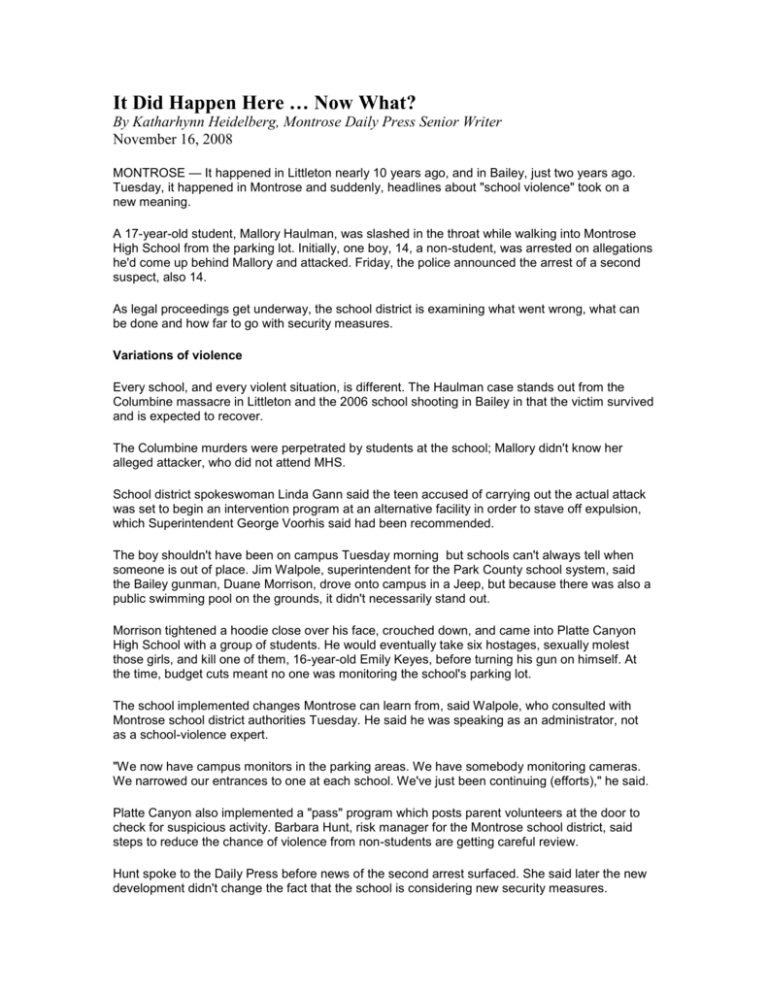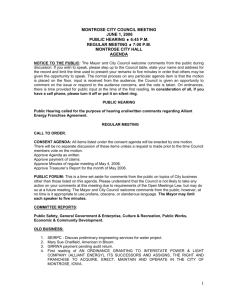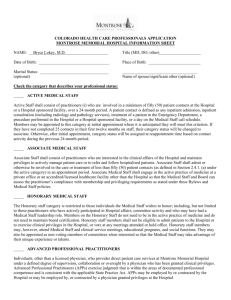It Did Happen Here … Now What
advertisement

It Did Happen Here … Now What? By Katharhynn Heidelberg, Montrose Daily Press Senior Writer November 16, 2008 MONTROSE — It happened in Littleton nearly 10 years ago, and in Bailey, just two years ago. Tuesday, it happened in Montrose and suddenly, headlines about "school violence" took on a new meaning. A 17-year-old student, Mallory Haulman, was slashed in the throat while walking into Montrose High School from the parking lot. Initially, one boy, 14, a non-student, was arrested on allegations he'd come up behind Mallory and attacked. Friday, the police announced the arrest of a second suspect, also 14. As legal proceedings get underway, the school district is examining what went wrong, what can be done and how far to go with security measures. Variations of violence Every school, and every violent situation, is different. The Haulman case stands out from the Columbine massacre in Littleton and the 2006 school shooting in Bailey in that the victim survived and is expected to recover. The Columbine murders were perpetrated by students at the school; Mallory didn't know her alleged attacker, who did not attend MHS. School district spokeswoman Linda Gann said the teen accused of carrying out the actual attack was set to begin an intervention program at an alternative facility in order to stave off expulsion, which Superintendent George Voorhis said had been recommended. The boy shouldn't have been on campus Tuesday morning but schools can't always tell when someone is out of place. Jim Walpole, superintendent for the Park County school system, said the Bailey gunman, Duane Morrison, drove onto campus in a Jeep, but because there was also a public swimming pool on the grounds, it didn't necessarily stand out. Morrison tightened a hoodie close over his face, crouched down, and came into Platte Canyon High School with a group of students. He would eventually take six hostages, sexually molest those girls, and kill one of them, 16-year-old Emily Keyes, before turning his gun on himself. At the time, budget cuts meant no one was monitoring the school's parking lot. The school implemented changes Montrose can learn from, said Walpole, who consulted with Montrose school district authorities Tuesday. He said he was speaking as an administrator, not as a school-violence expert. "We now have campus monitors in the parking areas. We have somebody monitoring cameras. We narrowed our entrances to one at each school. We've just been continuing (efforts)," he said. Platte Canyon also implemented a "pass" program which posts parent volunteers at the door to check for suspicious activity. Barbara Hunt, risk manager for the Montrose school district, said steps to reduce the chance of violence from non-students are getting careful review. Hunt spoke to the Daily Press before news of the second arrest surfaced. She said later the new development didn't change the fact that the school is considering new security measures. "Probably the biggest thing we're looking at right now is having kids wear their ID badges and verify they are students," she said Thursday, adding that the school would also have people to check the ID badges. She couldn't say how soon that might occur or whether the district would implement a parent-volunteer program. Though the second suspect is a student at Montrose High and would've had an ID badge, police weren't saying Friday whether he was actually present during the attack. He's accused of being a conspirator. Walpole said one of the most important areas to secure is a school's perimeter. "We've really put our efforts in trying to look at our grounds," he said. "There's been resistance to gates and fencing, but we're looking at some sensible ways to do that." Hunt said a lot has been done to control the perimeter at Montrose High. During school hours, only two doors are unlocked. There is already fencing at the school, and the building cannot be accessed from the Townsend Avenue entrance. School staffers are posted in the hallways, she said, and outside. "We have staff that are posted outside during lunch break who check kids in and out at all gate locations. That's something we're already doing." How far to go? At a press conference held Tuesday morning, Voorhis said some security measures the school might have to ultimately consider are "pretty draconian." Metal detectors, for instance, are controversial. "We will consider it, but we don't want to have a knee-jerk reaction," Hunt said. "We want something that fits our community and keeps our kids safe. I don't know that a metal detector would've helped. We don't want a fortress." Walpole said metal detectors weren't the answer at Platte Canyon. "We don't have metal detectors. There's a strong feeling in our community of not making it prisonlike. We've got to come to a sensible balance. One of the biggest lessons for me is, instead of thinking of the school door as the point to check, the more you can expand to the perimeter around the school, the better." He said security enhancements can only go so far. "The more eyes and ears you have, the more kids are willing to open up and tell somebody, but you can't guarantee it. You can just do the very best that you can do to eliminate factors and get faculty and students to report (warning) signs." Saying he believed it had prevented more school shootings, Walpole recommended Safe2Tell, an anonymous tip line established to allow students, parents, administrators and police to share information about potentially dangerous situations — not just possible acts of violence against others, but also to report students who may be pondering self-harm. The Safe2Tell program's statistics showed that in 81 percent of violent school incidents, someone other than the responsible party knew something was going to happen but didn't report it. "We're really pleased with Safe2Tell," Walpole said. No failsafe measures Walpole also said Montrose, which has offered counseling to students, should keep an eye on how students are dealing with the incident's aftermath. It should have a system in place to deal with mental health concerns, angry parents and other potentially volatile situations. "It does take time. Some kids are really impacted by these things and they start fearing coming to school. Those are things you have to watch out for," Walpole said. The day after the attack, attendance at Montrose High was at 94 percent, with only 17 reported absences due to the incident, Gann said previously. Mallory Haulman's parents said they don't hold the school district responsible and that Mallory is eager to return to class. But they are concerned about her recovering psychologically. Hunt agreed the incident was a learning experience for the Montrose schools. "Anytime we, or another school, have a situation, we're going to take something away from it. We want suggestions. We want ideas," she said. "We're examining every aspect to see what we can do to make it better and to prevent it happening again." She echoed the Haulmans, who previously indicated it's impossible to anticipate every bad thing that can happen. "There is no failsafe," Hunt said. "There is no way I can guarantee 100 percent of the time that something's not going to happen." School security measures will be discussed at the regularly scheduled parent advisory meeting Monday night at 7 p.m. The executive director of Safe2Tell, Susan Payne, is expected in town Monday and Tuesday, Gann said. "I think we all (have to learn) all the time," Walpole said. "They seem to have handled this well. I'm sure they'll go through, over and over, 'What can we do differently?' We continue to do that. It's just something in today's world that we have to try to stay on top of."






